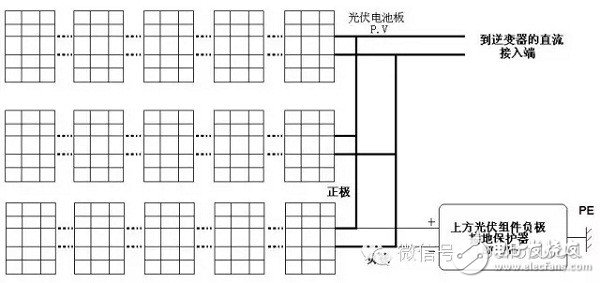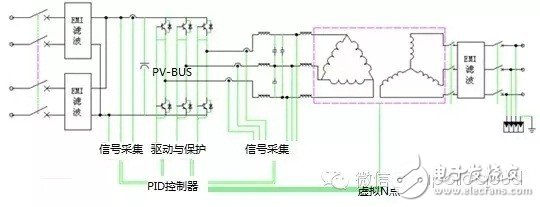How to reduce the power generation loss and increase the revenue while reducing the electricity price? -- Solving the PID problem is the key to increasing power generation.
The PID effect (PotenTIal Induced DegradaTIon) is also called potential-induced attenuation. It is the encapsulation material of the battery component and the material of its upper and lower surfaces. The ion migration occurs under the high voltage between the cell and its grounded metal frame, resulting in component performance. Attenuation phenomenon. The PID effect is most likely to occur under humid environmental conditions, and the activity level is positively correlated with temperature and humidity. At the same time, the attenuation phenomenon is related to the surface of the component being contaminated by conductivity, acidity, alkalinity and ions with ions.
Loss caused by PID
The following figure is a photo of a component that was tested by a PID experiment (196h) from a laboratory.

Obviously, if the component has long-term PID attenuation, it will inevitably lead to loss of power generation of the entire power station, or even power generation.
At present, the phenomenon of PID attenuation is not a case in China, especially in high temperature and high humidity areas, the most likely PID phenomenon.
PID solution - system level
This article does not consider the solution of the component itself, but the entire system PID solution.
1. Inverter (positive) negative ground
This solution is used earlier, and is currently available from most inverter manufacturers in the industry.
Working principle: For the P-type component, the negative pole of the string forms a potential difference of about 300V-500V with the ground. This potential difference will continue to cause ion migration on the surface of the component. The following figure connects the negative pole of the inverter to the ground through the fuse and circuit breaker. This raises the potential difference between the negative and ground potentials of the module to around 0V, thereby avoiding PID attenuation.

â–² Figure 1: Inverter grounding schematic

â–² Figure 2: Actual wiring diagram

â–² Figure 3: Final analog output
The advantages of the first scheme are outstanding, the system is simple, and the cost is low; but the disadvantages are also obvious. First, the negative pole of the inverter is grounded. If the PV is positive or the cable between the strings generates a ground fault, the fault current is generated through the ground line or generated. Arc discharge, easy to cause fire;
Second, if the operation and maintenance personnel accidentally touch the PV, the 600-1000V DC will be formed between the person and the earth, which is very harmful to the human body;
Third, the application is relatively limited, the cost is relatively high, and the isolation transformer takes up a large space;
This scheme is not suitable for string power plant applications, because this type of string inverter requires a double-winding isolation transformer or several string inverters to require a split isolation transformer. Therefore, this solution is more suitable for small-scale system applications or large-capacity centralized system solutions with isolation transformers.

â–² Figure 4: Cable arcing causes burnout
As the industry continues to develop, the cost of photovoltaic power generation has gradually declined, and the corresponding problems have come. Before 2013, the component PID problem that few people mentioned in the industry began to linger in our ears. The photovoltaic power station has been built into coastal cities, which makes the component PID problem more serious. To make matters worse, the grid-connected electricity price is adjusted every year.
2. Night compensation plan
This scheme was first proposed by SMA and stems from the reversible principle of PID attenuation.

â–² Figure 5: Night Compensation Plan
Working principle: The PV panel is connected to the positive voltage bias power supply. The power supply adds positive voltage to the PV panel at night, and the electrons lost due to the PID effect during the daytime work are pumped back from the PE. The PID is connected in parallel with the DC input of the inverter, applying a high voltage between the negative pole of the PV module and the ground, and supports outputting a fixed voltage and outputting an intelligently regulated voltage. At night, it releases the accumulated charge of the PV modules during the day due to the negative bias between the negative and ground, thereby repairing the PV modules that are attenuated by the PID effect.
The advantage of this solution is that the component power attenuation can be quickly recovered, but it must be ensured that the inverter is disconnected from the grid.
Disadvantages: high cost and high loss.
3, virtual potential
This program has been promoted and used by domestic inverter manufacturers in 14 years.

â–² Figure 6: Virtual Potential Schematic
Working principle: This working principle is to use the PV-BUS bus midpoint as the reference point when using the inverter AC output virtual N-line voltage acquisition; this scheme is to collect the PV-BUS bus voltage in real time through the collector, and the PID control module raises the inverter. The voltage from point N to ground is 300-500V, and the voltage at point N is raised to the half bus voltage, thereby raising the point-to-ground voltage of the PV-BUS bus of the inverter by 300-500V.
to sum up
The author believes that from the following dimensions, the current PID solution for photovoltaic power plants is a virtual potential solution.

This article considers the PID solution from the entire system side, and the author will also parse the PID solution from the component material side. I look forward to discussing it with my colleagues.
BANG DISPOSABLE 5000 PUFFS
The Puff filex Disposable Vape provides users with approximately 5000 puffs and is made with Low salt nic e-juice. It features a cylindrical design and uses a draw-activation firing mechanism for quick and easy vaping. Choose from any one of Flum Vapor's tasty flavors and find out what's your favorite.
The bang 5000 Puff Disposable Vape features a small box but big power! The flagon container design of this handheld vape pen provides a comfortable user experience. Once you hold it, you'll love it! Consisting of a dual coil, the ELF BAR 5000 puff disposable delivers the purest of flavors. Each bang bc 5000 vaporizer disposable is rechargeable which takes the stress out of running out of power. The contrasting colors of this handheld vape pen provide enjoyment, and personality on every puff!
5000 Puffs per Disposable
E-Liquid Capacity: 13ml
650mAh Battery
Dual Mesh Coils
5% (50mg) Strength Only
USB-C Charger not included
-STRAWBERRY KIWI FRUIT
-STRAWBERRY MANGO
-SOUR APPLE
-MANGO PEACH
-CRANBERRY GRAPE
-ENERGY
-PEACH MANGO WATERMELON
-STRAWBERRY ICE CREAM
-BLUEBERRY RASPBERRY ICE
-SAKURA GRAPE
-WATERMELON ICE
E Cig ,E Cigarette , Disposable Vape E Cigarette,5000 Puffs Disposable
Shenzhen Essenvape Technology Co., Ltd. , https://www.essenvape.com